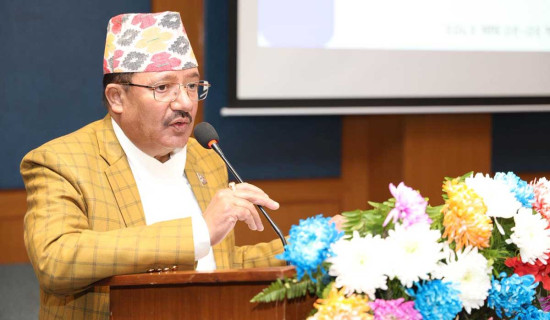- Thursday, 15 January 2026
Municipalities help communities to preserve water springs
BY A STAFF REPORTER,Kathmandu, Feb. 16; Municipalities in Kavrepalanchowk are taking initiatives to address the problem of water shortage by supporting community-led solutions to conserve water springs.
Seven municipalities of the district have backed the campaign to revive drying springs and pledged to adopt community-led solutions to address growing water insecurity.
A survey conducted in 2023 of 444 springs in Namobuddha Municipality found that nearly 20 per cent (93 springs) had dried up, with many others reporting a decline in water discharge.
Namobuddha, Panauti, Dhulikhel and Panchkhaal municilaities and Roshi, Bethanchowk and Temal rural municipalities have signed an agreement with the International Centre for Integrated Mountain Development (ICIMOD) to roll out an innovative Nature-based Solution (NbS) to water shortage.
An estimated 9 million springs are in the Hindu Kush Himalaya (HKH) region which serve as a critical water source for some 100 million people. However, springs are disappearing across the HKH due to climate change, over-extraction of groundwater, and land cover and land use change, exacerbated by road constructions leading to erosion and rock instability, read a press statement issued by ICIMOD on Thursday.
Water experts hope the landmark agreement will inspire other municipalities in Nepal and across the region, where water stress is already at a critical level particularly during dry seasons, to adopt spring shed management in their budgets and plans, read the press release.
“The disappearance of springs across the Hindu Kush Himalayas is a silent disaster,” said Sanjeev Bhuchar, Intervention Manager of the springs programme at ICIMOD. The issue has not received enough attention or investment, but these problems should be stressed to ensure mountain communities have continued access to drinking water, and water for livestock and crops and to prevent distress migration.
“The good news is that it is possible to bring springs back – to the huge benefit of communities across the mountains, and especially for women and adolescent girls, who bear an unequal burden of provisioning water for the household. We are delighted that municipalities in Kavre are taking this leadership role in sustaining water sources in the hills.”
Under the agreement, ICIMOD will help municipalities undertake an inventory of springs in their area, with details of their location and status, implement recharge interventions based on a study of the hydrogeology, and validate estimates of improved spring flows and water quality, and additional biodiversity and climate co-benefits. The analysis is designed to demonstrate a workable model that can be replicated in other areas where springs are drying up.
Pema Gyamtsho, Director General, ICIMOD said, “All our eight member countries have cited water insecurity and its impact on people, livelihoods and biodiversity, as a major concern, which is why we now have it as such a major focus of our work. I am delighted to see these municipalities leap deploying these crucial, socially inclusive and gender-responsive solutions to address and prevent further water stress in the region.”
ICIMOD’s Springs workstream is part of the Himalayan Resilience Enabling Action Programme (HI-REAP), supported by the Foreign Commonwealth and Development Office (FCDO), Government of the United Kingdom under their Climate Action for Resilient Asia (CARA) initiative, with co-financing from Frank Water, a social enterprise working on alleviating global water poverty.



-original-thumb.jpg)



-square-thumb.jpg)








